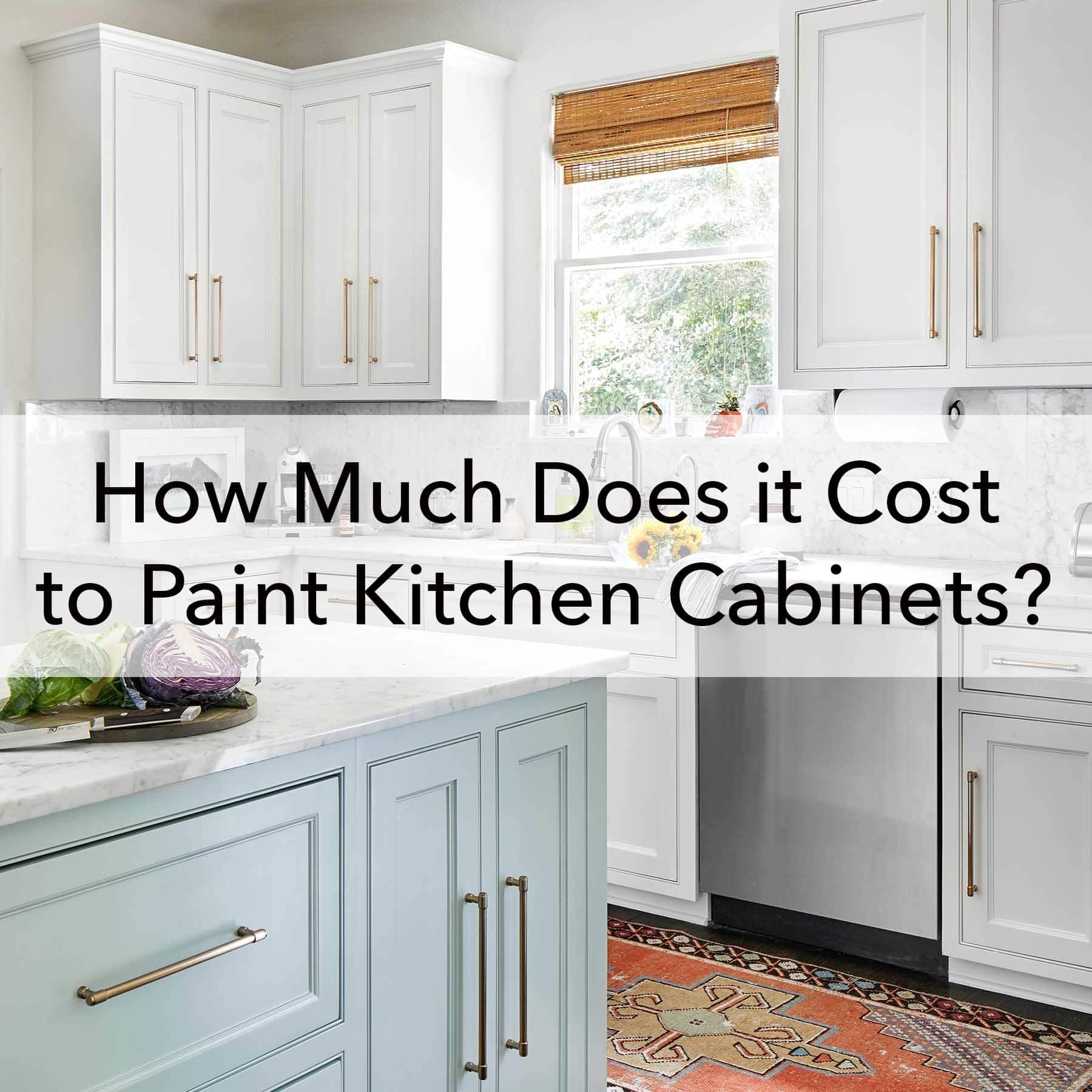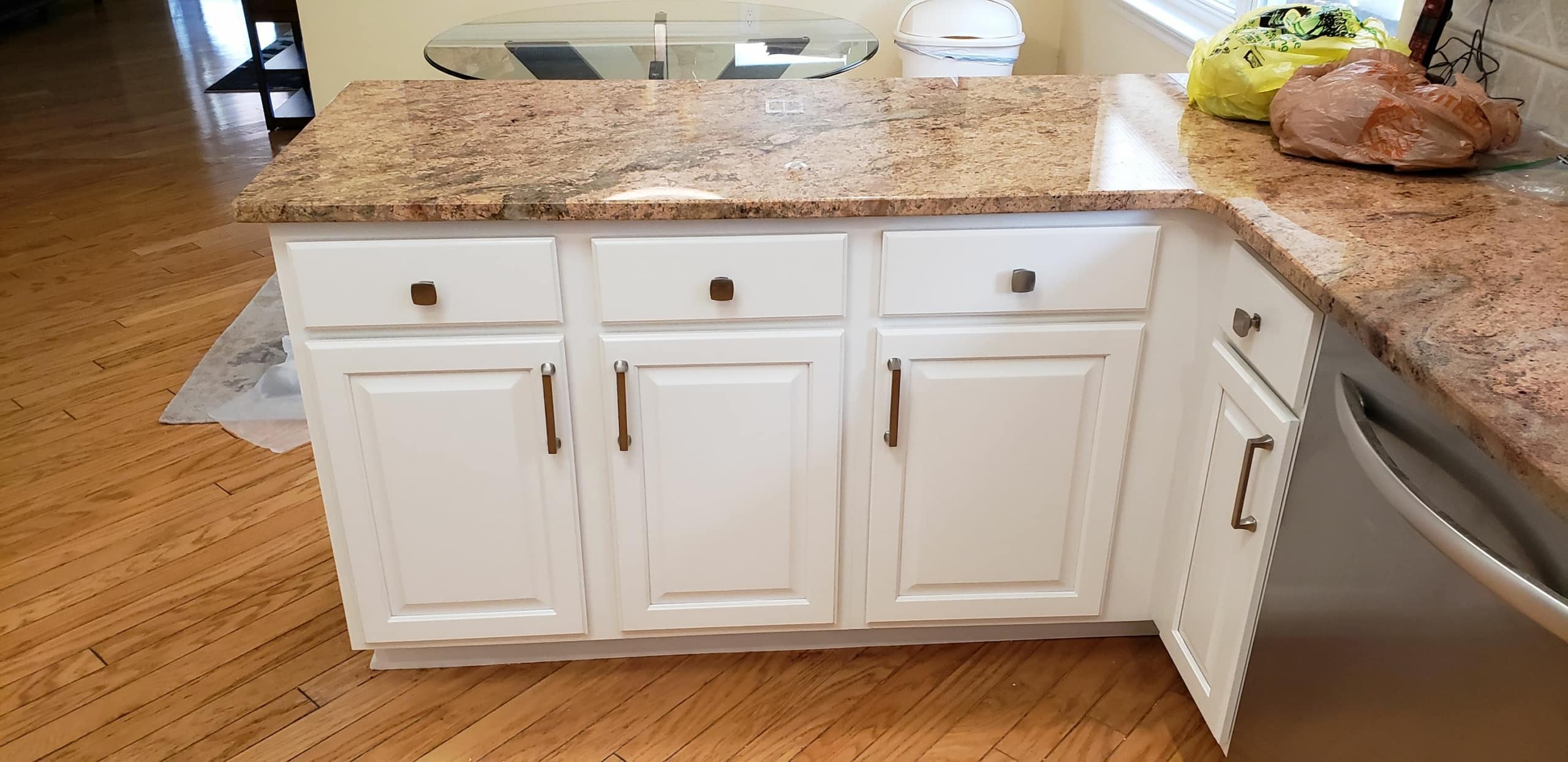Cost Factors Influencing Kitchen Cabinet Painting: How Much To Paint Your Kitchen Cabinets

Painting your kitchen cabinets can be a total game-changer, giving your space a fresh, modern look without breaking the bank (or, well, *too* much of the bank). But before you dive into those gorgeous new colors, let’s talk about the costs involved. Understanding the variables will help you budget effectively and avoid any surprise expenses.
Factors Affecting Kitchen Cabinet Painting Costs
The cost of painting your kitchen cabinets depends on a few key factors. Think of it like ordering a custom cake – more layers, more intricate designs, and fancier ingredients mean a higher price tag. Similarly, more complex projects will cost more. Here’s a breakdown:
| Factor | Description | Cost Impact | Example |
|---|---|---|---|
| Labor | Hourly rate or project fee charged by professionals. DIY significantly reduces this cost. | High | Professional: $50-$100+ per hour; DIY: $0 (except for potential tools) |
| Paint Type | High-quality paints (like Benjamin Moore or Sherwin-Williams) are more durable and offer better coverage but cost more. | Medium | High-end paint: $50-$100+ per gallon; budget paint: $20-$40 per gallon |
| Primer | Essential for proper adhesion and color consistency, especially on dark or glossy cabinets. | Medium | Primer cost can range from $20 to $50 per gallon, depending on the type and quality. |
| Cabinet Condition | Significant damage (chips, cracks, etc.) requires extra repair work, increasing the cost. | High | Minor repairs: minimal cost; extensive repairs: several hundred dollars. |
| Project Complexity | Number of cabinets, intricate details (e.g., carvings, glass inserts), and the level of surface preparation all impact the time and effort required. | High | Simple, flat-panel cabinets: lower cost; ornate cabinets with multiple layers: higher cost. |
| Cabinet Material | Wood requires different preparation and paint than laminate. | Medium | Solid wood may require more sanding and prep, while laminate may need specific primers. |
DIY vs. Professional Painting Cost Comparison
Choosing between DIY and hiring a professional significantly affects the final cost.
| Aspect | DIY | Professional |
|---|---|---|
| Labor Costs | $0 (excluding tool rental) | $500 – $3000+ (depending on project size and location) |
| Material Costs | Variable, depending on paint quality and quantity | Included in the professional’s quote |
| Time Investment | Significant time commitment, potentially several days or weeks | Completed within a defined timeframe |
| Potential Savings | Substantial savings on labor costs | None, but potentially higher quality and faster completion |
| Added Expenses | Potential for material waste, tool rental, and additional costs if mistakes are made | Higher upfront cost but potentially less risk of errors and rework. |
Cost Variations Based on Cabinet Material and Surface Preparation
The type of cabinet material directly impacts the cost. Solid wood cabinets often require more sanding and preparation than laminate, increasing the overall expense. For example, a heavily detailed, solid oak cabinet will require more time and effort for prepping than a simple, flat-panel laminate cabinet. This extra time translates to higher labor costs for professionals or a more significant time investment for DIYers. The type of primer needed also varies depending on the material. Oil-based primers might be necessary for certain wood types, while water-based primers may suffice for laminate.
Estimating the Cost of Painting Kitchen Cabinets: A Step-by-Step Guide, How much to paint your kitchen cabinets
Accurately estimating the cost requires a methodical approach.
1. Measure your cabinets: Calculate the total surface area of your cabinets to determine the amount of paint and primer needed.
2. Choose your materials: Select your paint and primer, considering quality and cost. Get quotes from several paint stores for better price comparison.
3. Estimate labor costs: If hiring a professional, get multiple quotes. If DIYing, factor in your time (and potential opportunity cost).
4. Account for additional costs: Include costs for sandpaper, brushes, rollers, drop cloths, cleaning supplies, and any necessary cabinet repairs.
5. Calculate the total: Add up all the costs from steps 2-4. Add a contingency of 10-20% to account for unexpected expenses. For example, if your initial estimate is $1000, add $100-$200 as a buffer.
Exploring Different Painting Methods and Their Costs

Painting your kitchen cabinets yourself can be a super rewarding (and cost-saving!) project, but choosing the right method is key to a pro finish. Different techniques offer varying levels of effort, skill, and, of course, cost. Let’s break down the options and see which one best suits your Pontianak style and budget.
Painting Techniques: Brushing, Rolling, and Spraying
The method you choose will significantly impact both the final look and your wallet. Consider these factors when deciding:
- Brushing: This traditional method offers great control and is perfect for detailed work like trim and intricate cabinet designs. However, it’s labor-intensive and can lead to brush strokes if not done carefully. Cost: Low (primarily paint cost). Pros: Precise control, good for detail work. Cons: Time-consuming, potential for brush strokes, requires skill.
- Rolling: Faster than brushing, rolling is suitable for large, flat surfaces. You’ll need a good quality roller and tray to avoid uneven coverage. Cost: Moderate (paint and roller supplies). Pros: Faster than brushing, good for large areas. Cons: Can leave texture, less precise than brushing.
- Spraying: The fastest and most even finish, spraying requires specialized equipment (a sprayer) and a well-ventilated area. It’s best for experienced DIYers or professionals. Cost: High (equipment rental or purchase, paint, potentially masking supplies). Pros: Fastest method, even finish. Cons: Requires specialized equipment, potential for overspray, needs good ventilation.
Cost-Effective Paint Choices for Kitchen Cabinets
Choosing the right paint is crucial for durability and longevity. Here are some budget-friendly options that still deliver amazing results:
- Semi-gloss or Satin Latex Paint: These are popular choices for cabinets due to their easy cleanup, durability, and resistance to moisture and scratches. They offer a nice sheen without being too shiny. Cost: Moderate. Impact on Project Cost: Moderate. Properties: Durable, easy to clean, good moisture resistance.
- High-Quality Enamel Paint: Enamel paints are known for their hard, durable finish, making them ideal for high-traffic areas like kitchens. While slightly more expensive upfront, the increased durability can save money in the long run by reducing the need for repainting. Cost: High. Impact on Project Cost: High. Properties: Very durable, scratch-resistant, excellent for high-traffic areas.
- Chalk Paint (with a sealant): Chalk paint provides a beautiful, matte finish and is easy to apply. However, it requires a sealant to protect it from moisture and wear, adding to the overall cost. Cost: Moderate (paint plus sealant). Impact on Project Cost: Moderate. Properties: Easy application, beautiful matte finish, requires sealant for durability.
Surface Preparation: The Foundation for a Professional Finish
Proper surface preparation is non-negotiable for a long-lasting, professional-looking paint job. Skipping this step will almost certainly lead to peeling and chipping.
- Cleaning: Thoroughly clean cabinets with a degreaser to remove grease and grime. Cost: Low (degreaser).
- Sanding: Sanding smooths out imperfections and ensures better paint adhesion. You’ll need different grits of sandpaper for different stages. Cost: Low to Moderate (sandpaper).
- Priming: A primer helps the paint adhere better and creates a uniform surface, especially important with darker colors or if covering stains. Cost: Moderate (primer).
- Caulking: Caulk gaps and cracks to prevent paint from cracking and chipping in those areas. Cost: Low (caulk).
Calculating Paint Needs
To determine the amount of paint needed, you’ll need to calculate the total surface area of your cabinets. A good estimate considers both the front and visible sides of the cabinet doors and boxes. Here’s a simplified formula:
Total Paint Area = (Number of Doors x (Door Height x Door Width) x 2) + (Number of Cabinet Boxes x (Cabinet Height x Cabinet Width) x 2)
Example: Let’s say you have 5 doors, each 30 inches high and 15 inches wide, and 10 cabinet boxes, each 36 inches high and 12 inches wide.
Total Paint Area = (5 x (30 x 15) x 2) + (10 x (36 x 12) x 2) = 4500 + 8640 = 13140 square inches
Remember to convert square inches to square feet (divide by 144) before checking paint can coverage (usually listed on the can in square feet per gallon). This will help you determine how many gallons of paint you need to buy. Remember to add extra for coats and potential spills!
Professional vs. DIY

So, you’re staring at your kitchen cabinets, dreaming of a fresh, vibrant look. The big question: hire a pro or DIY? It’s a decision that hinges on your budget, available time, and comfort level with a paintbrush (and maybe a sander!). Let’s break down the pros and cons to help you make the best choice for your Pontianak-style kitchen makeover.
How much to paint your kitchen cabinets – Choosing between professional cabinet painting and a DIY project is a significant decision. It impacts not only the final aesthetic but also your wallet and schedule. Let’s weigh the options, shall we?
Professional vs. DIY Cabinet Painting Comparison
| Professional Painting | DIY Painting |
|---|---|
|
Advantages: High-quality finish, professional-grade materials, faster completion time, less stress, warranty on workmanship. Disadvantages: Significantly higher cost, less control over the process, scheduling difficulties, potential for communication issues. |
Advantages: Cost-effective, complete control over the project, personal satisfaction, flexibility in scheduling. Disadvantages: Time-consuming, requires skill and patience, potential for mistakes, risk of lower-quality finish if not done properly. |
DIY Kitchen Cabinet Painting Checklist
Going the DIY route? Awesome! But proper planning is key. This checklist will help you avoid those frustrating “I forgot to buy…” moments.
| Item | Estimated Cost (USD) |
|---|---|
| Sandpaper (various grits) | $15 – $25 |
| Painter’s tape | $10 – $15 |
| Primer | $30 – $50 |
| Cabinet paint (high-quality) | $50 – $100+ (depending on quantity and brand) |
| Paintbrushes and rollers | $20 – $40 |
| Drop cloths and plastic sheeting | $15 – $25 |
| Cleaning supplies (rags, TSP) | $10 – $15 |
| Safety gear (mask, gloves) | $10 – $20 |
Potential Hidden Costs
Both professional and DIY projects can spring unexpected expenses. For professionals, this might involve discovering significant damage requiring repairs before painting can begin. I once saw a project where rotted wood needed replacing, adding hundreds to the final bill! For DIYers, it’s often about needing extra materials due to miscalculations or mistakes. That extra can of paint you didn’t plan for can quickly add up. Remember to always factor in a buffer for unforeseen issues.
